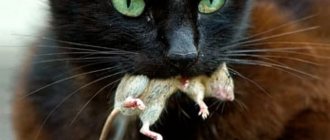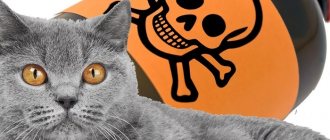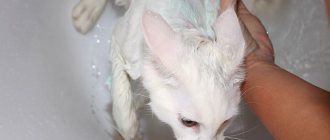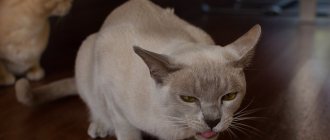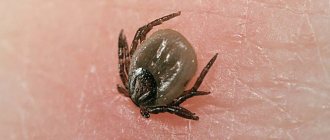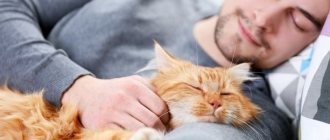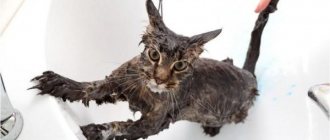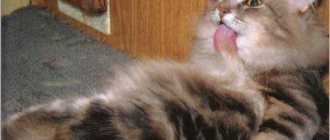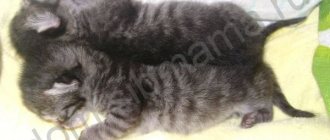Why do cats eat mice?
Hunting and eating tailed rodents is not only satisfying the hunting instinct, but also maintaining the cat’s health, which he is trying to ensure for himself at a natural level. The fact is that the brain of mice contains a large amount of taurine, which is vital for cats. This substance plays a huge role for the animal:
- regulates the operation of the central system;
- forms strong immunity;
- normalizes the process of blood clotting, preventing the opening of internal bleeding and promoting rapid healing of wounds;
- maintains the functioning of the reproductive system at the proper level;
- is a strong antioxidant that cleanses the body;
- facilitates contraction of the heart muscle, replenishing the necessary calcium concentration.
If the level of taurine in the body drops as a result of insufficient intake from food, the animal may develop heart and vascular diseases, as well as neurological disorders. When a cat suddenly starts catching and eating mice, this is a signal for its owner that it is necessary to reconsider its diet and introduce foods enriched with taurine into the diet.
Other elements necessary for a cat - sulfonic acids, which include methionine, cystine and cysteine, are found in mouse skin. These sulfonic acids are necessary to maintain the normal condition and thickness of the cat's coat. If a cat eats a mouse along with its skin and fur, it means that it is experiencing a shortage of these elements.
Predator on the hunt
Domestic purrs are predators. This means that the desire to catch and eat prey is inherent at the genetic level. Rat traps are especially prone to this. Kittens next to their mother learn to wash themselves and absorb her habits. The kids in the yard are watching the hunt; in a few months they will be able to catch a mouse on their own.
Our service is both dangerous and difficult
- nervous system,
- immunity,
- reproductive system.
When choosing a professional food, make sure it contains taurine.
Satisfying the hunting instinct
Even the cutest and fluffiest kitten once played the role of a hunter and predator in nature. After people domesticated cats and began using them as pets, they no longer needed to hunt for food. However, instinct periodically takes over and requires its manifestation in domesticated conditions.
Even if a cat’s body does not lack any elements to maintain health, hunting for mice is its natural need, a reflex that cannot be restrained. Catching mice is not just the job of barn cats. Many purebred kittens living in greenhouse conditions, once they see a mouse, will definitely chase it. But whether they eat their prey for lunch or not depends on whether they are tormented by hunger.
Rehabilitation process
Poisoning with rat poison is considered one of the most severe and most dangerous types of intoxication with toxic substances. The recovery process after it is quite long, especially in cases where it came to internal bleeding, but the animal was lucky to survive.
The prognosis for such poisoning depends on many reasons: how long ago and in what quantities the poison was eaten, how quickly the animal was given first aid, and whether the diagnosis was made in a timely manner and treatment began. Finally, a lot depends on how accurately the owner followed all the doctor’s prescriptions and whether he fed the cat only what the veterinarian advised her to give.
If it comes to internal bleeding, then the consequences can be even more serious: up to death from suffocation due to pulmonary hemorrhage or complete blindness resulting from a violation of the integrity of the capillaries in the eyeballs.
That is why, even after the cat has fully recovered, the owner should be especially attentive to the slightest changes in its health, which may be signs of the effects of zoocoumarin poisoning.
Unhealthy food
Cat owners, especially people living in private properties and houses, rejoice when their pets start hunting for mice - pests of the household, and do not find anything wrong with the fact that the hunter decided to feast on his trophy. On the one hand, eating mice is natural for cats, on the other hand, such a lunch or dinner can turn into a huge problem for the animal, and often for the owner himself.
Rodents, including mice, are carriers of dangerous diseases that can infect a pet and even transfer them to humans through close contact. After eating a mouse, a cat can become infected with the following infections:
- Rabies is a very serious disease that can be fatal if not treated promptly. The danger of this disease is that in the initial stages it does not manifest itself in any way, and at this moment the pet, even during play, can accidentally bite the owner, infecting him in the process. If a domestic cat often hunts mice, the likelihood that he will get rabies is extremely high, which means that such a pet poses a threat to all family members. You can protect animals and people from rabies infection by regularly vaccinating them.
- Trichinosis is caused by parasites - nematodes, which can live in the body of a mouse, and when a cat eats its meat, it can be transferred to it. The disease often affects cats that hunt rodents and eat their raw meat. The disease is characterized by damage to muscle fibers. The disease is very difficult to cure; there is no chance of a person becoming infected through contact with a sick animal.
- Toxoplasmosis is a disease quite common among felines that occurs as a result of eating raw mouse meat. The owner can also become infected from the pet. The peculiarity of the disease is that with primary infection it immediately becomes chronic, but without a symptomatic picture. Complications due to toxoplasmosis can only occur in people with immunodeficiency conditions. Toxoplasmosis is especially dangerous for women during pregnancy. The infection leads to the development of defects and anomalies in the fetus that are incompatible with life. If there is a woman in the family who is expecting a child, it is important to ensure that the indoor cat does not come into contact with street rodents.
- Tularemia is a disease transmitted by mice. A cat who eats their meat and a person who comes into contact with an infected member of the cat world can become infected.
- Salmonellosis is an intestinal infection with an acute course and severe symptoms. The owner can become infected with it from an infected pet who has eaten a mouse infected with salmonella.
- Leptospirosis – cats get this infection from rodents. The disease manifests itself as acute fever.
Best breeds
Obviously, not all cat breeds correspond to the hunting description given above. In addition, it is rare that any breed includes all characteristics without exception. At the same time, there are certain types of four-legged furry pets that cope better than others with catching rodents. Let's look at the main ones.
Maine Coon
The breeding of such a breed is largely due to the presence of hunting skills in the animals. Initially, they served as a kind of hunters, protecting grain warehouses from unwanted attacks by rodents.
Representatives of the Maine Coon breed are distinguished by a high level of mobility. In addition, they are resistant to external environmental conditions, so they can hunt rodents in any weather. Animals are also distinguished by a certain excitement: when they see a mouse, they will watch and track it for a long time - until they catch it.
Another important characteristic of the breed is the fact that its representatives have quite impressive sizes. In this regard, they are able to catch even large rats
Russian blue
Smoky-colored cats have an absolute advantage - they are able to move smoothly, but at the same time quickly and silently, thanks to which they take their prey by surprise. The Russian Blue breed is a classic example of rat-catching cats. This is stated not only by scientific research and theorists, but also by experienced breeders.
Siberian
If we characterize the process of catching rodents performed by Siberian cats, then first of all two terms should be mentioned: quickly and quietly. Help in the capture process is provided by the features of the animal’s anatomical structure, namely: the presence of fluff and fur on the paw pads, which insulate sound as the furry pet moves.
Representatives of the Siberian breed show great passion for catching rodents, and are also little attached to the owner. This is why you will more often find an animal hunting than lying in your arms.
Kurilian Bobtail
There is a widespread belief among breeders that animals of this breed have a character and behavior that is similar to the habits of dogs. Moreover, such characteristics appear in cats from childhood: they quickly become attached to their owners and fiercely protect them from any dangers and threats.
Thanks to the anatomical structure of the body, in particular, powerful paws, the animal can develop quite high speeds and also make long-distance jumps, which greatly simplifies the capture process for them.
Cymric
A cat of this breed prefers to live in private houses that have a local area, as he needs constant walks and active pastime. Representatives of the breed have quite dexterous and mobile paws, as well as tenacious claws, thanks to which they are able to catch rodents.
British Shorthair
In general, British shorthair cats are considered aristocratic and noble, but few people know that, among other things, these animals are also good hunters. An important role in this regard is played by the animal’s internal instincts and reflexes. The rather large dimensions of cats allow them to engage in fights and hunt even large rodents, even rats.
Safety regulations
If your pet lives in a private house where there are mice, and the likelihood of eating rodents is high, certain safety rules must be followed. First of all, this concerns vaccinating your pet against various infectious diseases transmitted by rodents. Vaccination should not be a one-time event. To protect your cat, it is important to follow the vaccination schedule and regularly take your animal for vaccinations.
The second safety rule concerns the use of various chemical agents to combat mice. Eating poisoned mouse meat, as already indicated, can result in severe poisoning and death for the cat.
If a cat actively demonstrates its hunting instinct towards rodents, it is prohibited to use poison with heavy chemical components. It's better to set mousetraps. They may not be as effective as spilled poison, but with mousetraps you don’t have to worry about the health and life of your pet.
Living toy
With adequate nutrition, the animal is protected from the need to obtain food and a source of microelements. But everyone loves to play. Be it a ball, a ball of thread or regular paper. It's more interesting to play with a moving object. Therefore, the mouse acts not only to satisfy hunger, but also as an opportunity to have fun. The animal catches up, throws it, presses it with its paw or squeezes the mouse with its teeth. At the same time, he does not seek to kill, but waits for the opportunity to start the chase again. As a result, the victim dies and the attacker loses interest.
Are you a toy or food?
This behavior is observed in relation to field mice - shrews. The cat catches and plays, but will never eat them. Firstly, representatives with narrow muzzles only look like rodents in appearance, but they are classified as moles. Secondly, their aroma is unpleasant. The glands on the front legs emit a musky odor that does not impress the hunter. This is why cats don't eat field mice.
How to stop a cat from catching mice
In order for an animal to stop hunting rodents and eating their meat, the owner needs to carefully monitor his pet’s diet, regularly give vitamins and buy food that contains all the useful minerals necessary to maintain health. Then the animal will not need to catch and eat rodents to compensate for the lack of taurine and sulfonic acids.
If a cat receiving a rational, balanced diet does not abandon its hunting instinct, continues to catch mice and can eat their meat, there is one fairly simple way to discourage it from the “bad” habit. You can hang a collar with small bells around your cat’s neck. The sound of bells while walking will be a signal to rodents that danger is close, and the mustachioed hunter will not be able to sneak up on the mice unnoticed.
If you want to take your furry pet to your dacha, you can protect it from infections transmitted through mice, and at the same time give it the opportunity to walk in the fresh air by making a large enclosure. However, in the evening it is recommended to take the cat into the house, since with the onset of darkness the mice will come out of their holes to hunt and can climb into the enclosure.
The cat became the first animal that was tamed by man in primitive times. Her developed hunting instinct did not go unnoticed. Regularly caught rodents on the territory of the house and land. An animal has become a friend, a companion, a family member, and a weapon against mice and rats. The question of whether cats eat mice or just catch them is asked by many owners after unusual finds in the house. The hunter brings the caught prey to the owners, shows off the trophy, and leaves it in a visible place.
Suitable breeds
The best mousecatchers are native cat breeds that appeared naturally and have not undergone significant transformation. Compared to artificially bred ones, hunting skills in such breeds have been developed over centuries, which has given the corresponding result.
Maine Coon
Maine Coon
Maine Coon cats are the best hunters of mice and rats. Maine Coons are distinguished by their large size and strength, which does not prevent them from gracefully jumping and chasing prey in hard-to-reach places. Maine Coons are gambling animals. A cat can chase a rat for hours, ignoring heat, cold, and rain. Thanks to its thick coat, the animal feels comfortable in the cold and can spend a long time outdoors. Large body sizes make it possible to destroy large rodents, which repel smaller rat catchers. Maine Coons prefer to spend time in the yard; country life is an ideal option for them.
Russian blue
Russian blue
Due to its compact size and aristocratic appearance, village house owners doubt the hunting skills of the Russian Blue cat. The lack of heavy weight is compensated by a quick reaction and the ability to move quietly around the yard. The Russian Blue cat tracks rodents of any size, which serves as the main entertainment for the pet. The cat's movements are graceful and precise, the speed of movement is amazing. The owners of Russian blue cats confirm that they hear any rustle and leave no chance for the mice to survive.
Siberian
Siberian
The skill of catching mice among Siberians has been confirmed by more than one generation. The pet is large in size and has thick fur, which allows it to pursue prey in any weather conditions, moving silently. The role of sound insulation is performed by fluffy pads on the paws. Siberian cats move in jerks and make long jumps, which allows them to cope with the prey. Since Siberians are not attached to their owner and home, pets spend most of their time outside, ambushing rodents. When the Siberian cat is busy tracking down prey, it ignores the call of a person and the feeling of hunger, plunging into the hunt. It is recommended to get a breed for people living in the northern regions.
Kurilian Bobtail
Kurilian Bobtail
They are distinguished by their attachment to the owner. Kurilian bobtails have a canine disposition and are ready to protect their owner from all threats and misfortunes. According to the cat, the main danger to humans is the mouse, so the pet devotes all its energy to tracking down and eliminating the rodent. Kurilian bobtails have powerful hind legs, allowing them to develop great speed and make long jumps. The animal moves from place to place with ease and is capable of destroying broods of mice. Thanks to its determination and courage, the Kurilian Bobtail is not afraid to get into a fight even with a medium-sized dog, so the owner does not have to worry about the safety of the yard. The cat will guard and defend the territory of the house until the end.
Nibelung
Nibelung
A rare breed of domestic cats with a difficult character. Nibulungs are proud and freedom-loving. The animal will not let a person near until it is convinced of his kindness and reliability. English origin and royal appearance do not prevent the Nibelungs from destroying the mice that have settled in the house. Due to their thick, long fur, Nibelungs require grooming, otherwise the pet will develop voluminous mats.
Cymric
Cymric
In appearance they resemble yard cats and have a short tail like a bobtail. It is believed that an elongated tail makes hunting easier, but practice shows the opposite. Thanks to the original structure of the body, the Cymrik is perfectly oriented in space and moves gracefully. Strong paws and sharp claws make the animal a successful rat catcher. Cats have a playful disposition and are active; they love to spend time outside, hunting for rodents. To stay fit and healthy, the animal needs long walks and fresh air. It is recommended to keep them in a private house in an open area.
British Shorthair
British Shorthair
Because of their cute faces and plush fur, Britons are considered sissies and couch potatoes, but these purebred animals make the list of the best rat catchers. The British have a well-developed hunting instinct and have the necessary inclinations. To please the owner, to receive rewards and praise, the animal is able to catch and bring prey in its teeth. Since British Shorthairs are compact in size (weighing rarely more than 5 kg), they often hunt mice and young rats. They rarely enter into battle with large individuals.
Reasons for eating rodents
When asked why cats eat mice, the answer always arises - because of hunger. The situation when a skinny cat sees a dead rodent and is in no hurry to touch it has dispelled this myth. Then why does the cat eat the mouse?
Nature has established an inextricable connection between cats and rodents. Mouse skin contains many useful trace elements, especially sulfur. They are necessary for the full development of the cat’s body and good health. Sulfur is a component of cystine and mythionine. The components are responsible for the health, beautiful coat, and mood of the cat. Meat should be included in the daily diet. In its absence, pets begin to get their own food.
Indoor cats will not chew mice, since their supply of sulfur comes with vitamins, which the owner constantly supplies them with. There is no feeling of hunger and access to food is unlimited. Therefore, you can see a cat eating a mouse on the street among the yard “residents”.
Diet disorder?
If the cat is on treatment or on a diet (for example, with kidney disease), then an eaten mouse or bird can negatively affect the treatment and the well-being of the cat itself. And if an infection or parasite gets into the body weakened by the disease, then the sick cat will not be able to fight it and will be more likely to become infected than its absolutely healthy brother.
Disadvantages of eating rodents
Can a cat eat mice? It sounds strange. These are two components of one chain. Cats should eat rodents in the wild, live indoors, but be outdoors frequently. In modern conditions, there are several risks from which pets should be protected.
- Cats should not be allowed to eat mice if there is a risk of poisoning. If neighbors use poison to control rodents, the cat receives a dose of mouse poison.
- The hunter should regularly receive medications against helminths, fleas, and ticks. Rodents are the main distributors of parasites. The pet must be protected.
- All routine vaccinations are required. Mice spread many terrible diseases. Some of them are transmitted to humans through pets after contact with a mouse.
A cat brings prey into the house for several reasons - to brag about its achievement to its owners, to “feed” them, to hide them from barn cats, to eat them later, as a reserve for a rainy day.
Cats eat mice, but not all of them. This requires not only hunting instincts, but also certain living conditions. Yard kittens are capable of conducting the most brutal hunt for rodents already at 5 months of age.
Hunting for mice is not a whim, but a vital need of small cats, at least those that do not sit at home, but are forced to earn their daily food by the sweat of their faces. Mice are a unique supplier of amino acids, without which it is extremely difficult for cats to live.
The content of the article:
Treatment of the disease
The first symptoms and treatment of cats that have eaten poisoned mice are inextricably linked. You need to understand that every lost second will aggravate the pet’s condition. The first step is to give the animal drugs that can cause vomiting. If there is vomiting, then you need to rinse the cat’s stomach with an enema, and then give him crushed activated carbon tablets. Unfortunately, in most cases, when the process of internal bleeding has already started, the pet will need a blood transfusion. Considering the fact that most veterinary hospitals do not have the appropriate equipment, the owner needs to be as efficient as possible.
Vitamin K is a natural antidote to rat poison, so it is given by injection after treatment begins. When the cat's condition becomes stable, it can be given in tablet form. Vitamins are administered in large doses, since anticoagulants will destroy most of them. Vikasol is perfect for these purposes, since other multivitamin preparations and specifically vitamin K are low in them. Under no circumstances should a cat be allowed to drink if it is poisoned. If the dose was high, internal bleeding will quickly develop and the pet will die.
Different manufacturers of rat poison use different combinations of anticoagulants in their poisons. This raises difficulties in determining when to stop treatment. Experts recommend stopping treatment after a minimum period of 10 days, and then, two days later, taking the cat's blood for analysis, where the platelet level is carefully examined. If it is reduced, then therapy should be continued, but if it is normal, then it can be stopped.
Principles of healthy eating
Biologists and doctors know that any amino acid performs two related functions - it supplies building material to protein chains and supplies the body with energy. Often animals need amino acids from outside, since they are not able to produce them themselves . Such amino acids are called essential. In cats, this is taurine - it is not produced in the body, but is responsible for the performance of its main organs.
Zoologists have found that the highest concentration of taurine is found in the retina of a cat's eye (100 times more than in the blood). This is why taurine deficiency primarily affects vision: the retina degenerates, and the animal quickly and irreversibly goes blind.
In addition, taurine takes care of the heart muscle, where it accounts for half of all free amino acids. Taurine regulates the transport (from and inside the cell) of calcium ions, facilitating heart contractions. A lack of amino acids immediately affects the activity of the cardiovascular system, causing such a terrible disease as dilated cardiomyopathy.
Important! Whatever your cat’s diet (natural or made from industrial food), the main thing you must ensure is the presence of taurine in it.
Taurine, recognized as an effective antioxidant, has a number of additional, but no less important tasks:
- regulation of the nervous system;
- formation of active immunity;
- normalization of blood clotting;
- maintaining reproductive functions;
- synthesis of bile salts, without which fats in the small intestine are not digested.
Diagnostics and veterinary care
Based on the results of the examination, treatment is prescribed.
The process of identification and diagnosis is carried out by taking tests and examining the external condition of the animal; you will also need to do an ultrasound to determine whether there is damage to the internal organs.
Based on the results of the identification and examination, treatment and preventive measures are prescribed to strengthen the body. In the event that a cat has been poisoned by a poison that the owner used to get rid of rodents on his own, then during the visit it is necessary to provide the veterinarian with a container of poison - this will help to minimize the time for diagnosis and prescribing a course of treatment.
Inducing vomiting
Emetic root syrup will help induce vomiting in a cat.
One effective treatment is to induce vomiting. Emetic root syrup in an amount of 3–4 ml will help with this. Also, as an option, if there is no vomiting root, you can give the cat regular warm boiled water to drink, then make the movement characteristic of inducing vomiting - forcefully but gently press on the root of the cat’s tongue.
Treatment
It is necessary to give the cat plenty of clean water.
But you also need to give your cat plenty of clean, regular (not boiled) water. A necessary drug that prevents further bleeding and possible complications is vitamin K1. Course of treatment – 1–3 weeks
It is important to remember that the vitamin should be given only 2 hours after taking the adsorbent. The exact dosage is determined by the veterinarian during administration.
Why does a cat eat mice?
Owners of mouse-cats notice that the latter do not always eat the whole mouse, often being content with its head. The explanation is simple - in the brain of rodents there is a lot of taurine, which enters the cat's body during meals. By the way, mass ailments among domestic cats began after the appearance of the first batches of factory-made food in Europe and the USA, when cats stopped catching mice, as they were forcibly transferred to ready-made diets.
Important! The trio of sulfonic acids (cysteine, cystine and methionine), which support cat health, are also responsible for the quantity/quality of fur, stimulating its growth. It is possible that the cat also realizes the benefits of mouse skin, saturated with the original element, sulfur, which is why it eats the mouse completely and along with the fur.
After some time, the cats began to get sick more, lose their eyesight and suffer from heart disease . After a series of studies, it turned out that the body of cats (unlike dogs) is not able to synthesize taurine from protein foods. Taurine is not for nothing called a sulfonic acid or sulfur-containing amino acid - it is not formed in the body without cysteine (another sulfur-containing amino acid).
First aid
If your cat has been poisoned by rat poison, you should immediately seek help from a veterinary clinic. When there is no opportunity to see a doctor or you have to wait a long time for him, it is better to start treatment immediately. To do this you will need:
- Induce vomiting in the animal. This is done so that the poison, which has not yet been absorbed, comes out along with vomiting. But such a procedure is appropriate if the cat ate food or a suspicious rodent in front of you. If a lot of time has passed, then vomiting will cause dehydration and will only worsen the poisoning, since the poison has long since entered the intestines. In order to induce vomiting in a cat, you can use a 3% solution of hydrogen peroxide diluted 1:1 with warm water. The amount of peroxide is calculated based on the weight of the animal, 1 teaspoon per 2 kg of weight. You can also use a concentrated solution of ordinary salt. It is best to pour such solutions from a syringe after removing the needle from it.
- To bind the poison, the animal is given any adsorbent drug, for example, activated carbon or Enterosogel. The adsorbent is diluted with warm water and injected into the cat in an amount of 100 ml using a syringe.
- To prevent the poison from getting into the animal’s blood, you need to give something enveloping, such as egg white or starch paste.
When the animal has already had a good drink (and no earlier than 3 hours later), it is given any laxative - petroleum jelly, magnesium solution or others.
Also, when a cat is poisoned by rat poison, enemas can be done to wash the stomach. To do this, saline solution or ordinary boiled water, but only at room temperature, in an amount of 20-30 ml is injected into the cat's anus using a pear.
But, of course, it is best to contact a veterinary clinic for qualified help at the first symptoms or suspicion.
Mice in the diet - harm or benefit
Rodents are as beneficial as they are harmful to cats, at least according to veterinarians who are concerned about the “bouquet” of diseases transmitted by the former. It is believed that mice (like rats) are carriers of infectious diseases that are dangerous both for the pets themselves and for their owners.
The list of such diseases includes:
- trichinosis - difficult to treat and caused by helminths that parasitize the intestines (larvae penetrate muscle tissue and destroy it);
- ringworm ( ringworm ) is a fungal infection that affects the appearance of the coat/skin. The therapy is simple but long-lasting;
- leptospirosis - affects various organs and is accompanied by fever. A cat becomes infected through contaminated water, eating mice or coming into contact with their secretions;
- toxoplasmosis is dangerous for pregnant women and is often asymptomatic. About 50% of rodents are considered carriers of the disease;
- salmonellosis is an acute intestinal infection that threatens humans and animals;
- tularemia , pseudotuberculosis and others.
Hypothetically, a cat that eats mice could become infected with rabies, but this probability is reduced to zero if the animal is vaccinated. The second thing that should reassure the owner is that the virus is transmitted through saliva, that is, the mouse must injure the cat.
Important! Those who live in private homes and keep rat-catching cats say that their animals hunt rat mice for many years, avoiding any infectious diseases. Several generations of cats live to a ripe old age, enriching their daily diet with rodents without tragic consequences for health.
A cat is more likely to be poisoned if it tastes a mouse that has died from the poison used in deratization. If the poisoning is mild, you can get by with pharmaceutical absorbents; in case of severe poisoning (vomiting, diarrhea with blood, liver/kidney failure), call a doctor immediately. Also, when in close contact with rodents, pampered domestic cats often pick up fleas or helminths.
"Atrocious" problems
Cats themselves are very likely to “pick up” fleas (blood-sucking parasites that also serve as carriers of helminthiasis), helminths (worms) and protozoa from mice. A person can also suffer from them, but if hygiene rules are followed, this happens extremely rarely.
Another specific, incurable and difficult to diagnose disease is trichinosis. It is caused by helminths from the group of nematodes that parasitize the intestines. Their larvae infect muscles, penetrating the tissue and destroying it. A cat becomes infected by eating meat, including rodents. The disease is also dangerous for people, but it is not transmitted from cats - only through food.
Poisoning also occurs in hunting cats. Their strength depends on the dose and type of poison that enters the body. Most often, poisoning manifests itself as mild gastrointestinal disorders, which can be treated with any absorbent drug. But there are also severe cases when the cat’s internal organs (kidneys, liver) are affected, acute diarrhea with blood, lethargy, and refusal to eat begin. In such cases, delay is extremely dangerous; it is necessary to show your pet to a veterinarian as soon as possible.
Instincts or fun
Yard kittens, forced to fight for existence, hunt mice like adults from the age of 5 months. In the USA, they conducted an experiment in which they established a connection between the living conditions of kittens and their hunting reflexes, first by mating purebred and street cats with one cat. The litters, after they were born, were swapped - the purebreds were given to the yard mothers and vice versa.
As a result, it turned out that initial hunting skills were inherent in both groups, since mothers regularly carried mice to their litters. The difference appeared at the next stage: the street cat killed rodents and gave them to kittens, while the purebred cat only played with the mouse.
Important! The researchers concluded that to consolidate the reflex of catching/eating living creatures, instinct alone is not enough, but skills acquired through education are necessary.
On the other hand, a kitten growing up isolated from its fellow cats independently learns the basic wisdom of a cat (washes itself, sharpens its claws, snorts, relieves itself, meows pitifully or angrily) and is quite capable of catching a mouse. Another question is whether he will eat it or not. If a kitten is very hungry, it is unlikely that the lack of a mother's example will stop him.
Yard VS Thoroughbred
The hunting instinct is alive in every cat, regardless of the presence or absence of breed. But in order to have the honor of being called the best hunter, the degree of expression of this instinct is important. In most cases, a purebred cat catches a mouse simply out of curiosity. She doesn’t try to eat her and doesn’t even always kill her: over the years of selection, breeders have managed to euthanize the cats’ natural inclinations, making these animals more suitable for life in a city apartment.
So which cats are better at catching mice? It turns out that they are outbred? However, this is not always the case. Many owners deliberately breed completely domestic mongrel cats, but these cats also live in urban conditions, in apartments, and they see mice no more often than their blue-blooded brothers. If suddenly such a cat catches a rat, it plays with it for a long time, drags it back and forth, without trying to kill it with a precise bite to the back of the head, as real hunters do. And all because, in addition to a pronounced instinct, a cat requires skill. But how to teach a cat to catch mice?
This experiment was carried out back in the 1960s. Four cats and their offspring took part in it. The two cats were pedigree, and the cats for mating were selected accordingly. The other two are skilled hunters living on farms, mated with the same cats. Scientists made a substitution: outbred kittens were placed in purebred cats, and purebred babies were placed in farm cats. When the litters were not even three weeks old, the outbred cat caught a mouse and brought it to “her” kittens. The second yard dog did the same
The hunters taught the purebred kittens to handle their prey with caution and surgical precision. Outbred kittens raised by purebred “mothers” learned only to play, but not to kill - they were not given such an opportunity. As a result, it became obvious which cats are better at catching mice: those that were born and raised in certain conditions, with access to natural prey, raised by rat catchers and with small claws knowing why, in the opinion of hunting cats, nature created mice and other small animals. living creatures
As a result, it became obvious which cats are better at catching mice: those that were born and raised in certain conditions, with access to natural prey, raised by rat catchers and with small claws knowing why, in the opinion of hunting cats, nature created mice and other small animals. living creatures
This experience proved that, despite the importance of heredity, upbringing and the conditions for raising litter play a decisive role in the issue of catching rodents. Therefore, when choosing a future thunderstorm of mice, you should rely on the conditions of keeping the kittens
Ask your neighbors about this question: there is almost certainly a cat living on one of the adjacent plots, whose owners annually adopt kittens born from the gulena
Therefore, when choosing a future thunderstorm of mice, you should rely on the conditions of keeping the kittens. Ask your neighbors about this question: there is almost certainly a cat living on one of the adjacent plots, whose owners annually adopt kittens born from the gulena
You can bring a rat catcher into a private home directly from the street - a kitten born in the basement already has the necessary skills at the age of three to five months. What breeds of cats catch mice? These are animals of natural proportions, raised in a nursery in a suburban area (with access to the street, and not living in enclosures). These include our Siberians, Russian Blues, Thais, Kuril Bobtails and overseas beauties - Maine Coons, Abyssinians, Bengals, Ocicats, European Shorthairs.
Is it possible to stop eating mice?
Modern cats (with the exception of those who sit on pasture) have stopped eating caught mice: they are brought to their owners as proof of their dexterity and diligence, often in gratitude for human care. In addition, a cat will not eat a mouse if it has had enough to eat. If you don’t want your pet to eat rodents, watch the energy value of its usual food.
There is an option - to put on a collar with tiny bells: this way, the cat will not only not eat, but, above all, will not catch the mouse . A side effect is the annoying rattling of the bell, which not everyone can withstand. If your cat starts chasing mice at your dacha, build her an enclosure where she can frolic until the evening: in this case, all the day’s prey will remain in the enclosure, and you will take the cat into the house in the evening. This method is also not flawless - most personal plots are not designed for unplanned structures.
This is interesting! The most ingenious development is considered to be the development of one meticulous programmer, who came up with a compact automatic door for his cat named Squirrel. The guy got tired of bumping into cat trophies (strangled mice/birds in different corners of the apartment) and he designed a door that opened in front of the “empty” cat and did not open if he was holding something in his teeth.
The programmer taught the camera standing at the entrance to analyze the image (which was simultaneously broadcast to the web server), comparing it with a template, and make a decision about allowing the object into the house.
It will also be interesting:
Those who are far from the world of computer technology can cope with the problem in a radical, albeit not entirely humane way, by once and for all banning their cat from going out into the yard.
First aid
- If a cat is poisoned by a mouse that dies from the poison, symptoms will not be visible soon.
- But directly eating the poison itself will affect the health of your pet very quickly.
- Hematomas will become visible on the body. Bruising on the gums and nosebleeds will be noticeable.
- The body succumbs to spasms and convulsions. In case of poisoning with poisons and rodenticides, disorientation in space will appear, the animal’s head will shake and its paws will tangle.
- The cat will develop diarrhea and vomiting. Traces of blood will be visible in the vomit or stool.
- In case of poisoning with zinc phosphides, a rotten smell from the mouth and breathing problems will appear.
- Signs include refusal to feed, complete apathy, and even fear of people.
- Possible shortness of breath and tachycardia.
Even one of these signs should alert you, especially if there is information about rodent control measures, if there is even the slightest chance that the cat has eaten poison or a poisoned mouse.
If you observe any signs of intoxication in an animal, you must urgently take it to a veterinary clinic or call a doctor at home.
At the same time, if calling for help is difficult (for example, the locality is located far from a veterinary clinic), the owner must help the pet right at home.
What to do before the doctor arrives:
- If a poisoned mouse or poison for mice and rats was eaten by a cat right in front of the owner, it is worth inducing vomiting using a solution of hydrogen peroxide diluted in a ratio of 1 to 1 (one teaspoon diluted per 1 kg of body weight). You can also induce vomiting in an animal by placing a pinch of soda on the tongue. If the duration of the poisoning has not been established, it is not recommended to induce vomiting: this will only cause dehydration of the exhausted body;
- To bind a toxic substance in the stomach, the cat must be given an adsorbent: enterosgel, activated carbon, polysorb. The drug is diluted in 100 ml of water at room temperature and poured into the mouth using a syringe. Adsorbents are not used if the cat does not stop vomiting;
- To cleanse the intestines, the animal is given an enema of 30 ml of warm boiled water or saline solution.
After poisoning with zinc phosphide, you need to rinse the cat's stomach with a 0.5% solution of copper sulfate or a weak solution of soda.
To provide your cat with the most effective help, you need to know exactly what kind of poison the animal was poisoned with. To obtain this information, you need to do a special analysis in the laboratory. However, it is not always possible to immediately contact a veterinarian for help; in this case, you must act without delay on your own.
After this, you need to adhere to a consistent algorithm of actions that will help your pet recover. If you neglect the following rules and recommendations, this will lead to the death of the cat. Before giving the cat an absorbent, it is necessary to induce a gag reflex in the pet.
You can do this in the following ways:
- Mix equal parts hydrogen peroxide solution and plain water.
- Pour 4 ml of emetic root into the pet's mouth, which can be purchased at any pharmacy.
- Dissolve a couple of tablespoons of table salt in a glass of water.
- Sprinkle some baking soda on the tip of your tongue.
- Give the cat water to drink, then press on the root of the tongue.
It will be more convenient to give the cat the above solutions using a regular medical syringe.
It is very important to force a poisoned cat to drink a sorbent in the form of activated carbon after vomiting. This will help relieve intoxication and neutralize the poison.
Also, in addition to coal, Enterosgel can be used as an effective sorbent.
After the above procedures, you should do the following:
Two hours after the cat has taken the sorbents, it is necessary to give him vitamin K1, which will help neutralize the internal bleeding that has begun.
The dosage is calculated based on the level of poisoning and the intensity of bleeding. An hour after the above procedure, it is very important to cleanse your pet’s intestines. To do this, you can use laxatives: sodium sulfate solution 2% or castor oil. You can also do an enema to flush the intestines; this will be much more effective and safer for your pet.
35 ml of purified water or saline solution should be injected into the rectum.
It is very important to understand that your pet is currently experiencing the most difficult hours of his life. If your cat has been poisoned, treat him as carefully and gently as possible, do not expose him to stress
Care and rules for feeding a cat after poisoning with rat poison
Care and proper diet are the key to a speedy recovery for your pet.
On day 2-3, the animal can be switched to a gentle diet:
- food should be fresh and easily digestible;
- per day, the cat should eat 4-6 times in small portions;
- there should be no coarse, abrasive particles in food: to avoid injury to irritated mucous membranes, products should be minced, crushed or pureed;
- lean boiled meat is acceptable: beef, chicken fillet, veal;
- lean boiled fish, chicken or beef liver;
- boiled vegetables, pureed: carrots, broccoli, beets;
- slimy porridges: oatmeal, rice, buckwheat (can be diluted with raw egg yolk).
As the pet recovers, raw meat and fish, dairy products (kefir, low-fat milk), and raw eggs are returned to the pet’s diet.
The following products are prohibited:
- factory-made canned food;
- dry cat food (irritates the gastric mucosa);
- legume products;
- meat by-products;
- bread and pasta;
- sweets.
If the animal has no appetite, you should not force it to feed; it is better to consult a doctor about the use of IVs.
You need to monitor your pet’s well-being and contact a veterinarian at the first symptoms of poisoning. The life of a cat depends on the attentiveness of the owner and the timeliness of his actions.
Do you need to see a veterinarian?
After all the measures taken, the animal still needs to be taken to a doctor for a detailed examination.
Despite the fact that the owner has already provided first aid to a cat poisoned by a mouse, a visit to the veterinary clinic is still required. This precaution is due to the fact that this type of cat poisoning can even cause the death of the pet.
Only a veterinarian can carry out the necessary diagnostic measures and prescribe the appropriate course of therapy. In addition, after poisoning, the owner will need to monitor the pet’s diet, which is also recommended by the veterinarian.
Symptoms of animal poisoning
Refusal to eat and severe weakness are symptoms of intoxication.
The symptoms are characteristic of poisoning by poison, and not from the food that the cat ate.
Main manifestations of the problem:
- Complete refusal to eat;
- Severe weakness;
- Difficulty breathing for no apparent reason;
- Tachycardia;
- Internal bleeding;
- External bleeding
- High temperature (above 40 0);
- Vomited;
- A large number of bruises;
- Convulsions;
- Hypertonicity of the body and legs.
Conclusion
Poisoning with rat poison is very dangerous for a cat: if the animal survives, which does not always happen, the consequences of intoxication can affect its health for years. It's easier to prevent your cat from getting poisoned
To do this, you need to be especially careful when using drugs to kill rodents in your backyard or country house. And residents of city apartments should take warnings about deratization carried out in their area very seriously: do not let their cat outside on these days and, just in case, keep on hand everything necessary to provide first aid to your pet
If the cat is still poisoned, it is necessary to take him to the clinic as soon as possible to make a diagnosis and begin treatment.
